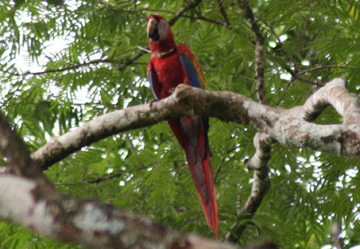Wild parrots tracked by satellite for the first time
mongabay.com
August 5, 2007
Researchers are now tracking wild parrots from space.
For the first time, Wildlife Conservation Society scientists have successfully fit two adult scarlet macaws in Guatemala’s Maya Biosphere Reserve with satellite tracking collars. The biologists hope to learn more about habitat use and migration patterns of the species, which is listed on Appendix I of CITIES (Convention on the International Trade of Endangered Species).
“We know where these birds nest, but we have no idea where they go and how they use the surrounding landscape for the rest of the year,” said WCS-affiliated researcher Dr. Robin Bjork. “The collars will enable us to track these wide-ranging birds and help inform management strategies to protect the species in Guatemala.”

Collared macaw. Courtesy of the Wildlife Conservation Society |
The scientists aim to recapture the birds during the 2008 nesting season to remove the collars. Failing to do so, the collars will eventually fall off on their own.
WCS recently announced it will invest $3 million over the next five years in the Maya Biosphere Reserve. The funding will be used to create a network of protected areas that will span more than 3,800 square miles.
This article is based on a news release from WCS